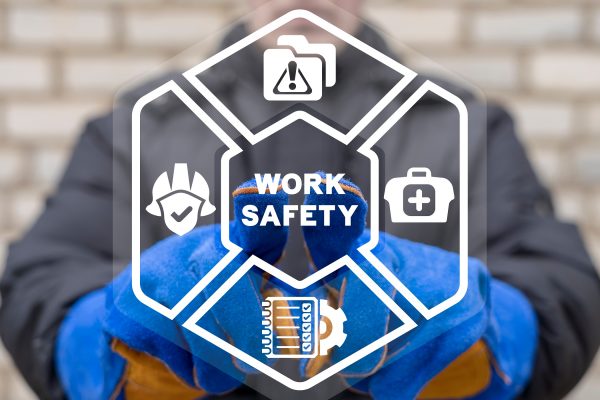Winter is cold! Obviously, this we know; but the risk to health and safety caused by the low temperatures that may be experienced by outdoor workers, or those working in low temperature indoor work environment can be effectively managed.
UK Health and Safety law does not prescribe any minimum working temperature; rather employers are required to create and maintain a work environment that is thermally comfortable.
Most people will recognise that if there are no doors and windows to a building (i.e. during construction); or if the nature of the work requires that doors be open, for example as a means access (or even ventilation) then it becomes both impracticable and wasteful (in terms of energy) to maintain a constant temperature above 0O Centigrade. In such instances Employers and Managers (and employees) must look to other ways of protection from the cold.
When working outdoors the effects of the weather in the UK during the winter can potentially have a serious impact on an employee’s health, especially if the risks have not been considered or properly managed. This impact may be immediate, or it may occur over a longer period of time.
When working outdoors the cold weather can have influence an individual’s effectiveness and therefore possibly their safety whilst at work. A cold winters day is not readily managed using just engineering controls. In these circumstances some of the most effective ways of managing cold working conditions is to introduce some simple administrative controls to protect the workforce.
• Ensure the PPE used, or clothing that is worn is appropriate for the nature of the work, i.e. waterproof and providing thermal protection. Any thermally protective clothing must offer protection against the cold – if it does not, it is classified as ‘workwear’.
• Provide mobile facilities for warming up where practicable, and encourage the drinking of hot fluids such as soup or hot drinks;
• Introduce more frequent rest breaks;
• Inform workers about recognising the early symptoms of cold stress.
Outdoor working
Anyone working in a cold environment may be at risk of cold stress. Some workers may be required to work outdoors in cold environments and for extended periods of time. Cold stress can be encountered in a cold (sub-zero) work environment. The following frequently asked questions will help workers understand what is meant by cold stress, how it may affect their health and safety, and how it can be prevented.
How cold is too cold?
What constitutes extreme cold and its effects can vary. A cold work environment forces the body to work harder to maintain its temperature. Whenever temperatures drop below normal and wind speed increases, heat can leave the body more rapidly.
Wind chill is the temperature the body feels when air temperature and wind speed are combined. For example, when the air temperature is 40°F, and the wind speed is 35 mph, the effect on the exposed skin is as if the air temperature was 28°F.
Cold stress occurs by driving down the skin temperature and eventually the internal body temperature (core temperature). This may lead to serious health problems, and may cause tissue damage, and possibly death.
Some of the risk factors that contribute to cold stress are:
• Wetness/dampness, dressing improperly, and exhaustion;
• Predisposing health conditions such as hypertension, hypothyroidism, and diabetes;
• Poor physical conditioning

One of the largest independent specialist motor trade brokers in the UK. Our extensive history of supplying insurance to the motor trade means we understand your business needs. By partnering with a specialist insurance broker like us, you get exactly what you need to protect your business.
In a cold working environment, most of the body’s energy is used to keep the internal core temperature warm. Over time, the body will begin to shift blood flow from the extremities (hands, feet, arms, and legs) and outer skin to the core (chest and abdomen). This shift allows the exposed skin and the extremities to cool rapidly and increases therisk of frostbite and hypothermia.
Combine this scenario with exposure to a wet environment, and trench foot may also be a problem.
What are the most common cold induced illnesses/injuries?
• Hypothermia
• Frostbite
• Trench Foot
Employers should use safe work practices. It is easy to become dehydrated in cold weather. Employers can provide plenty of hot sweetened liquids to workers to reduce this risk. Worker must avoid alcoholic drinks. If possible, employers should consider scheduling outdoor work during the warmer part of the day.
Employers can assign workers to tasks in pairs (buddy system), so that they can monitor each other for signs of cold stress. Workers can be allowed to interrupt their work, if they are extremely uncomfortable due to very cold conditions. Employers should give workers frequent breaks in warm areas. Acclimatise new workers and those returning after time away from work, by gradually increasing their workload, and allowing more frequent breaks in warm areas, as they build up a tolerance for working in a cold environment. Safety measures, such as these, should be incorporated into the relevant health and safety plan for the workplace.
Dressing properly is extremely important to preventing cold stress. The type of fabric worn also makes a difference. Cotton loses its insulation value when it becomes wet. Wool, silk and most synthetics, on the other hand, retain their insulation even when wet. The following are recommendations for working in cold environments or when working outside:
• Wear layers of loose-fitting clothing. Layering provides better insulation. Do not wear tight fitting clothing. Wear an inner layer of wool, silk or synthetic to keep moisture away from the body. Wear a middle layer of wool or synthetic to provide insulation even when wet. Wear an outer layer to provide wind and rain protection (that allows some ventilation to prevent overheating.)
• Wear a hat or hood to help keep your whole body warmer. Hats reduce the amount of body heat that escapes from your head.
• Use a knit mask to cover the face and mouth (if needed).
• Use insulated gloves to protect the hands (water resistant if necessary).
• Wear insulated and waterproof boots (or other footwear).
Safety Tips for Workers
Your employer should ensure that you know the symptoms of cold stress. You should monitor your physical condition and that of your co-workers and dress properly for the cold. Remember to stay dry in the cold; because moisture or dampness, e.g. from sweating, can increase the rate of heat loss from the body. You should also keep extra clothing (including underwear) handy in case you get wet and need to change. Drink warm sweetened fluids (no alcohol).
Use any proper, safe work practices developed by your employer and personal protective equipment (PPE) provided by your employer. This could include thermally protective PPE and/or suitable workwear clothing.
Do keep in mind that working in cold conditions isn’t just uncomfortable, it can be dangerous. Frostbite, numbness, dehydration and hypothermia are real concerns from chilly outdoor weather. If you’re working outdoors this winter, be aware of the dangers and stay safe.
1. STAY WELL NOURISHED BY EATING AND DRINKING ENOUGH
Make sure that you do drink enough fluids, as you dehydrate faster in cold weather conditions. Dehydration causes headaches, dizziness and fatigue, and it’s important to stay alert outdoors. Eating enough food during the day, especially fats and carbohydrates, is also important. Your body uses those nutrients as energy to stay warm in cold temperatures.
2. STAY WELL RESTED
Working outdoors can be challenging and increases risks to your safety. Make sure you’re getting enough sleep to stay alert on the job when conditions are more dangerous.
3. PLAN BREAKS FROM THE COLD
Just like you need to take breaks from your work throughout the day, your body needs to take breaks from the cold. Plan warm-up times throughout your day to avoid numbness and shivers.
4. STAY DRY
Damp clothing can quickly drop your body temperature. It’s more important than ever to stay dry in the cold. Wear a moisture-wicking base layer to draw away sweat as you work. Wear waterproof gear as an outer shell to prevent under layers of clothing from getting wet. Change out of any wet clothing as soon as you can.
5. DRESS FOR THE CONDITIONS
Dressing in layers is key, as it not only keeps you warm but allows you to adjust to changing temperatures. Proper gloves, socks and footwear are essential in cold working conditions. Choose headwear that keeps your head and ears warm. Balaclavas can also help to warm your neck and warm the air you’re breathing.
6. KEEP A COLD WEATHER SAFETY KIT IN YOUR VEHICLE
If you’re on the road, make sure to take a cold weather safety kit. A cold weather kit should include emergency blankets, candles, and matches. A candle burning in a vehicle could provide enough warmth to ward off hypothermia for a period of time.
Before you work outdoors in cold weather conditions, make sure that you’re well prepared. Be aware of the dangers of exposure and follow these tips to make safe choices.
The temperature in a workplace should normally be at least 16 degrees Celsius. If work involves rigorous physical effort, the temperature should be at least 13 degrees Celsius.
These temperature guidelines do not apply where it would be impractical to maintain those temperatures, for example in rooms which have to be open to the outside.
HR Manager, an easy to understand, simple to use piece of software that enables you to manage all aspects of HR, , Health and Safety, Employment Law and GDPR compliance for your business. HR Manager is FREE and available to all Lawgistics members. Call 01480 455500 to start using HR Manager today.







